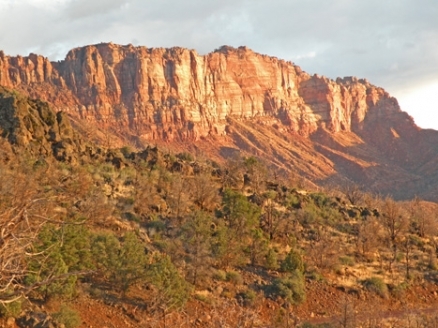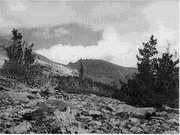Nevada-Utah Mountains Semidesert - Coniferous Forest - Alpine Meadow Province (Bailey)
The Nevada-Utah Mountains Semidesert - Coniferous Forest - Alpine Meadow Province embraces the central Great Basin, Utah high plateaus and Tavaputs Plateau of the Colorado Plateau with a total land area of approximately 43,600 mi2 (112,900 km2).
Land-surface form
This province covers the highest areas of the Great Basin and Colorado Plateau (Colorado Plateau Semidesert Province (Bailey)), including valleys that are 5000 ft (1500 m) in elevation. The topography is characterized by a number of closed valleys, none of which containing perennial lakes. Streams are rare and few are permanent. Many linear mountain ranges rise steeply from the semiarid plains, reaching altitudes up to 13,000 ft (3960 m). They are composed mostly of folded and faulted sedimentary rocks block faulted to produce basins and ranges. To the east, on the Colorado Plateau, the mountains are formed from high-elevation plateaus composed of dissected, horizontally layered rocks.
Climate
This region has a high-altitude variation of the temperate desert climate, with a very pronounced drought season and a short humid season. Most precipitation falls in winter, despite a peak in August. Winters are long, and climate varies considerably with altitude. Average annual temperatures range from about 38F (3°C) 50°F (10°C) in the valleys to 50°F (10°C) 38°F (3°C) on upper mountain slopes. Average annual precipitation ranges from five to eight inches (130 to 200 mm) in the valleys to 25 to 35 in (640 to 890 mm) at higher elevations. A considerable portion of winter precipitation is snow, and summer afternoon thunderstorms are common on the Colorado Plateau.
Vegetation
Sagebrush dominates at lower elevations. Other important plants in the sagebrush belt are shadscale, fourwing saltbush, rubber rabbitbrush, spiny hopsage, and horsebrush. All tolerate alkali to varying degrees, essential to their survival on the poorly drained soils widespread in the region. Where salt concentrations are very high, even these shrubs are unable to grow; they are replaced by plant communities dominated by greasewood or saltgrass.
The woodland belt above the sagebrush zone is similar to the corresponding belt on the Colorado Plateau, with juniper and pinyon occupying lower mountain slopes. The belt is frequently interrupted as mountains give way to plains.
In the montane zone above the woodland belt, ponderosa pine generally occupies the lower and more exposed slopes and Douglas-fir the higher and more sheltered ones. Typical species of the subalpine belt are alpine fir and Engelmann spruce. Great Basin bristlecone pine, with some individuals more than one thousand years old, occupies widely scattered peaks. Only a few mountains in this province rise high enough to support an alpine meadow belt.
Soils
Aridisols dominate all basin and lowland areas; Mollisols and Alfisols are found at higher elevations in the mountains. Salt flats and playas without soil are extensive in the Great Basin.
Fauna
Sagebrush shrublands provide ideal habitat for pronghorn antelope and whitetail prairie dog. Golden-mantled squirrels inhabit the region's ponderosa pine forests, and snowshoe hares along with red squirrels are found throughout the spruce-fir forests of Utah.
The sagebrush shrublands contain many species of birds, ranging from burrowing owls to such specialized species as sage sparrow and sage thrasher, both found in no other type of habitat. Various raptors prey on jackrabbits, including the American kestrel, ferruginous hawk, and golden eagle. The pinyon jay is typical of the pinyon-juniper forest, which also supports the plain titmouse and black-throated gray warbler, along with flocks of bushtits. Ponderosa pine forests contain the Steller's jay and dark-eyed junco.
Many reptiles can be found in this province; collared lizards are common.
References
- Donald L. Baars. 2000. The Colorado Plateau: a geologic history. UNM Press. 254 pages
Return to Ecoregions of the United States
| Disclaimer: This article contains information that was originally published by the United States Forest Service. Topic editors and authors for the Encyclopedia of Earth have edited its content and added new information. The use of information from the United States Forest Service should not be construed as support for or endorsement by that organization for any new information added by EoE personnel, or for any editing of the original content. |

